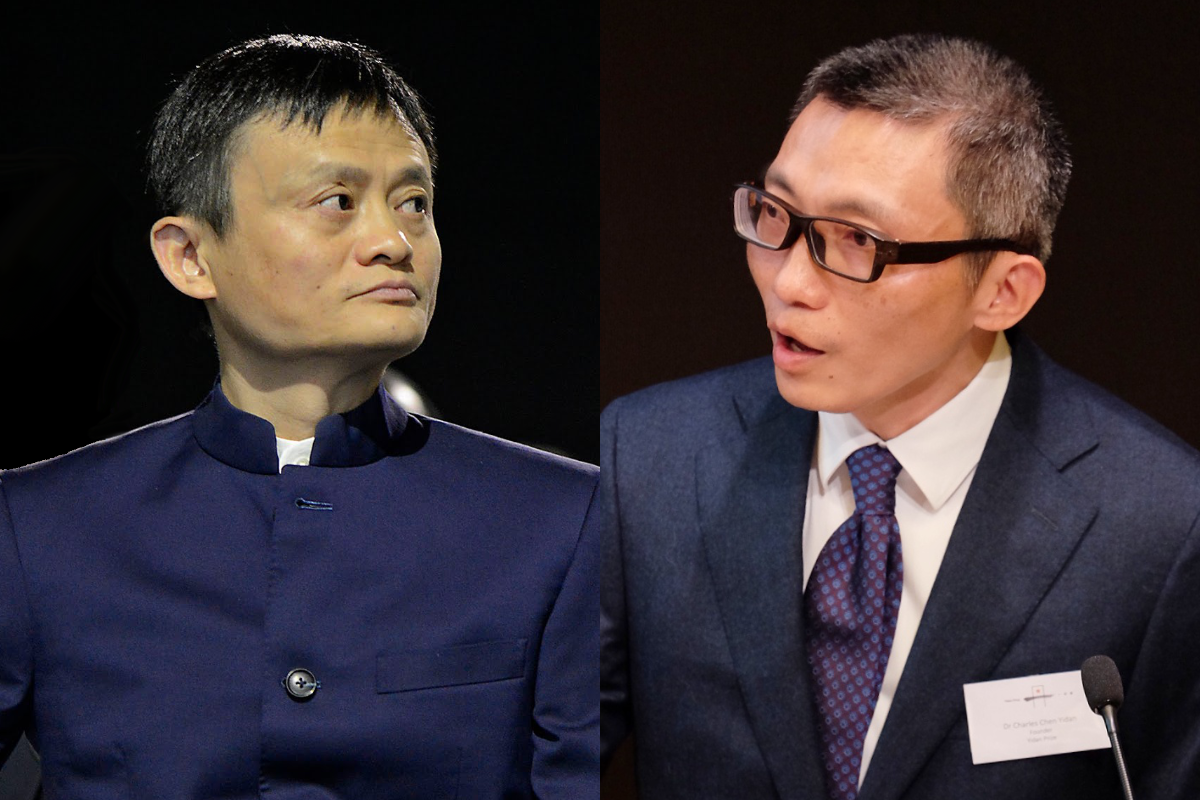The problems with giving it all away: Philanthropy in China
In this week’s The China Project Signal, we’ll take a look at the current state of philanthropy in China, trace some of the most significant trends in its explosive expansion over the last decade, and consider what the future may have in store for this dynamic sector.

In September 2018, the co-founder and executive chairman of ecommerce giant Alibaba, Jack Ma (Mǎ Yún 马云), announced he would be retiring from the company to focus more fully on philanthropy in education, one of his longtime personal interests. Ma’s newest endeavor has put him in esteemed company; in 2013, the co-founder of Tencent and its chief administrative officer, Yidan “Charles” Chen (Chén Yīdān 陈一丹), similarly stepped down from his enormously successful tech company to work on his own large-scale philanthropic initiatives — also with a focus on education. Both Ma and Chen have established and generously funded charitable organizations bearing their own names, and frequently appear at the top of lists of philanthropic giving in China.
Ma and Chen are of course only part of a much larger story, one that is reshaping the relationship between the private sector and Chinese society at large: the growing size and impact of philanthropy. In this week’s The China Project Signal, we’ll take a look at the current state of philanthropy in China, trace some of the most significant trends in its explosive expansion over the last decade, and consider what the future may have in store for this dynamic sector.
Philanthropic donations in China are at an all-time peak — especially for educational causes
According to a recently published report by the Asian Philanthropy Venture Network, the total amount of domestic philanthropic donations in China in 2017 reached USD $23.4 billion dollars. (For reference, this was around the size of Iceland’s nominal GDP.) This is the highest recorded annual amount of philanthropic giving in modern Chinese history. Further, if the last few years of year-on-year growth rates are any indication — not to mention the influence and enthusiasm of high-profile philanthropists like Jack Ma and Charles Chen — the philanthropic sector looks likely to continue to grow in coming years.
Of the $24 billion donated to philanthropic causes in China in 2017, the vast majority was provided by Chinese corporations rather than individuals; $14 billion and $4 billion, respectively. (Remaining sources of philanthropic donations included Chinese foundations and bequests.) The composition of corporate versus individual donations stands in sharp contrast to the nature of charitable giving in the U.S., where gifts made by individuals accounted for 72 percent of all donations made in 2017, and corporations only 5 percent of the total. As will be discussed in greater detail below, this is the result of a number of institutional and regulatory factors unique to China, but it also suggests that Chinese corporations and individuals alike have a very different sense of philanthropic obligations than counterparts in the U.S.
Regardless of who was doing the giving, in 2017, as in prior years, education proved by far the most popular cause for philanthropists in China. Research by the Harvard Kennedy School’s Ash Center suggests that the strong emphasis on educational causes (as well as other forms of “single-issue giving”) stems at least in part from concerns about the maturity of the philanthropic sector overall, including the ability of independent foundations or social organizations to be properly accountable for donated funds. By focusing on single issues or recipient organizations, philanthropists are also in a position to build stronger relationships or draw on existing ones, contributing to a greater sense of trust overall. Of course, other background factors are almost certainly at play; even in the U.S., which boasts comparatively rigorous oversight mechanisms for charities, Chinese-American philanthropists also exhibit a marked preference for educational causes.
Whatever the reason, according to a report by the Chinese Global Philanthropy Initiative, in 2014, philanthropic contributions to educational causes constituted 62 percent of all donations for that year alone. These education-focused donations consisted primarily of gifts made directly to universities, to be used in building and improving facilities and scholarships to needy students — significantly, all examples of relatively straightforward types of gifts that could be easily measured and monitored. Other perennially popular causes among Chinese philanthropists are poverty alleviation, public health, and environmental protection, though this latter issue area receives significantly less attention from donors than its counterparts. In general, according to the Ash Center, individual donors in China are much less inclined to give to social problems they view as falling within the purview of government, or complex causes that require more strategic forms of giving. Further, there is a perceived security in giving exclusively or primarily to high-profile organizations or issue areas, for reasons explored below.

A dynamic decade — and a bumpy regulatory ride — for Chinese philanthropy
Charitable giving in China took off suddenly in 2008, in the aftermath of the massive earthquake in Sichuan Province. This tragic event marked the first time that millions of ordinary Chinese people engaged in philanthropy rather than a few ultra-wealthy individual donors or corporations, and marked a significant turning point in the way Chinese society at large viewed the practice. While it would take seven years to top the record initially set by Chinese donors in 2008, the steady rates of increase in individual and corporate donations in the years to follow strongly suggest that philanthropy has been firmly integrated into the values of key private sector actors.
However, even as money began pouring in for charitable causes, the legal and regulatory framework governing giving struggled to catch up. Though the first Chinese foundations established during the reform era were set up as early as 1981, it was not until 2016 that a specialized law was passed to regulate the philanthropic sector as a whole. Not coincidentally, the Charity Law of the People’s Republic of China (中华人民共和国慈善法 zhōnghuá rénmín gònghéguó císhàn fǎ) was passed on the heels of a number of significant scandals that rocked the nascent philanthropic sector. These widely reported incidents raised serious concerns among donors about the ability of foundations and social organizations to responsibly handle funds, not to mention effectively tackle the social ills they purported to address. Figures within civil society also lobbied and advised the government to pass legislation that would better incentivize would-be donors by improving tax benefits, removing obstacles that prevented some nonprofit organizations and private foundations from legally registering, and strengthening government oversight and management of philanthropic organizations in general. Almost immediately, the law appeared to have had the desired effect: Between 2015 and 2016, when it came into effect, philanthropic giving grew 20 percent year-on-year.

Two years into implementation of the Charity Law, while growth of the philanthropic sector has fluctuated somewhat in response to global economic trends, the outlook remains largely positive. To quote from a The China Project Access online Q&A with Chinese philanthropy expert Oma Lee in April 2019: “In terms of on-the-ground implementation after two-plus years, I would say: 1) More specific regulations have clarified tax and registration issues; 2) People are more confident in the NGO sector because there is an accountability mechanism and public information disclosure requirements; [and] 3. More people are willing to give because they have more confidence that money is spent accountably and [they] get tax breaks.” As Lee noted later in her interview, in addition to the government’s efforts to improve regulations, universities and private companies are also working to professionalize the philanthropic sector and develop a more widespread culture of charitable giving.
A look ahead — and the view from the ground
Moving forward, even with the Charity Law and related regulations, much remains to be done to ensure continued growth and efficacy of philanthropic efforts. For example, while private wealth has grown dramatically in recent years, rates of personal giving remain relatively low as compared with other countries with similar rates of high-net-worth individuals. At the same time, the recipients of donations themselves tend toward the homogenous; beneficiaries are usually well-established foundations or institutions that often have government ties. Donations to smaller, grassroots groups and non-governmental organizations (NGOs) that focus on local, niche, or politically sensitive topics are less plentiful, and some of these organizations have found it difficult to legally register. In this regard, the Charity Law has had a similar impact to another law passed a year later that governs the activities of foreign NGOs, as reported previously by The China Project. The increased government regulation and scrutiny in the philanthropic sector can therefore be said to have come at a high price indeed for groups working on politically sensitive issues — no matter how just or necessary the cause.
The complexity of these issues are not lost on newly minted full-time philanthropists like Jack Ma. As he famously noted in 2015 at the opening ceremony of a new degree program in nonprofit management at Peking University: “It’s harder to donate money to Chinese charities than to earn it.” Hopefully, government measures like the Charity Law and the tireless efforts of Chinese philanthropists and nonprofit professionals alike will make all the difference.






